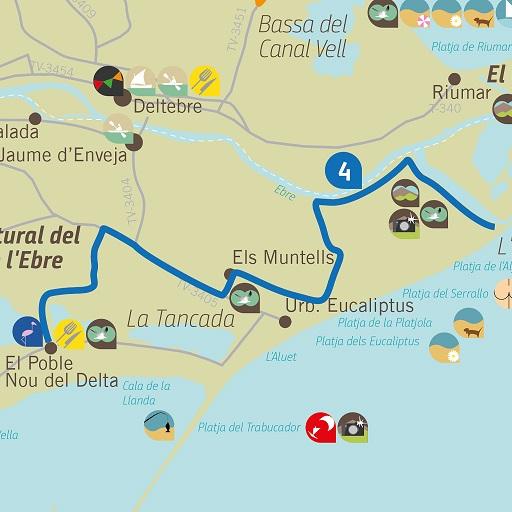Route 4. Encanyissada and Migjorn - Alfacada
Departure point: Poble Nou del Delta
Duration: full day
Route by car: 25,1 km
Route on foot: 100 m
Circular: no
Poble Nou del Delta is the starting point for this route, leading to the Pont de Través viewpoint, where there is a raised observation tower and a viewpoint adapted for people with reduced mobility. You can choose to look to the south or the north, depending on the position of the sun for the best light. On one side we have a very lush lagoon with a wide range of aquatic birds, including red-crested pochards and common pochards, there is a dense reed bed where you can hear Savi's warbler and the last Iberian reed buntings on the Delta. On the other side we have the Clot, with less reedbeds, but it is no less interesting as Caspian tern, common tern and spoonbill are common species here. You should also keep a look out for numbers of osprey passing through.
Continuing along the paved track you can go to the Casa de Fusta, the park's information centre. If you turn south, along a dirt track which is in good condition, you arrive at Embut viewpoint. From here you can see similar species as those at the Pont de Través viewpoint, but furthermore with the green filters there is impressive movement of glossy ibis and other species from the roosts to the feeding points. Having crossed the filters on the main road, you come to a crossroads and head towards Els Muntells. From here on you are in an area dominated by rice fields where a large number of birds from Buda Island, such as glossy ibis, night herons and grey herons gather to feed. Finally, go back to the main road that leads to Migjorn beach where the road ends. It is worth going to the large observation tower from where you have great views of the Violín area, Alfacada, “Els Calaixos” of Buda Island and the seafront, with the chance to see more than 70 different species of birds without leaving that space. It is probably the best place to be sure of seeing species such as spoonbills, purple swamphens, greylag geese, ruffs and a great range of ducks. The highest number of observations of rare or irregular visitors to the Ebro delta, such as the marbled teal or the white-headed duck, have been from this tower. Looking out to sea, in good conditions, you can see storm petrels and sea ducks such as the common scoter and the surf scoter.
Phenology:
The “calaixos” (coastal lagoons) of Buda are famous in the winter period, when thousands of ducks from most of the species present in Europe find shelter and food in these waters. Also in these months, boreal parasites and other birds are seen looking at the shoreline. Shallower areas are especially interesting in the months of April-May and August-September due to the incredible diversity of wader birds that gather here.
Track GPX
We also make the route file available to you in gpx format so that you can use it with your GPS device (see link in the header).






